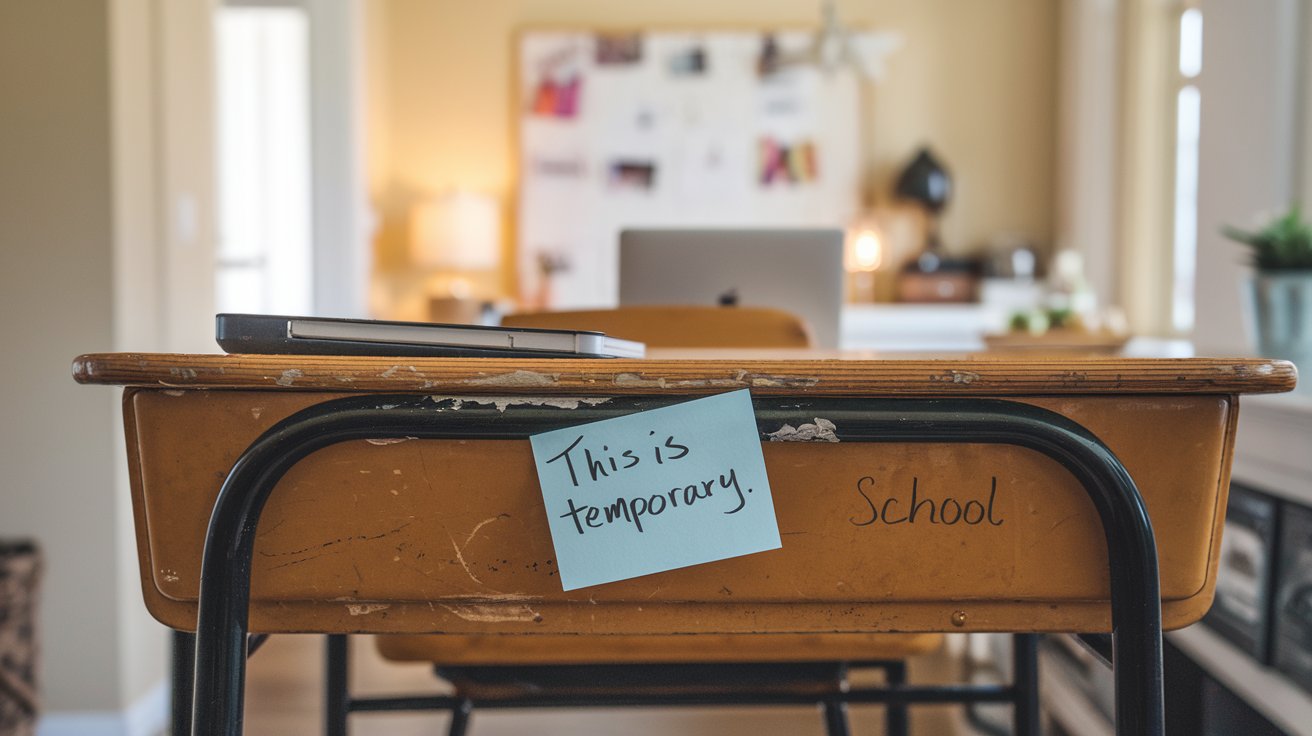Your cart is currently empty!

Teacher Voice Strain: A Long-term occupational hazard
After over two decades in education, I’ve discovered another teacher challenge: voice strain. Constant projection across bustling classrooms, combined with the need to maintain engaging lessons throughout each day, isn’t what our voices were designed for. For experienced educators, this isn’t just about temporary hoarseness—it’s a career-defining challenge that we must actively manage.
This post may contain affiliate links. At no cost to you, I may earn a small commission if you click on any affiliate link within my blog. Some of the content on this website was created with the help of AI.
Teaching is a rewarding profession, but it comes with a unique set of challenges. It is one of the most voice-intensive jobs, with teachers using their voices for an average of six hours per day. One of the most significant issues many Australian teachers face, including myself, is teacher voice strain. Constantly projecting my voice in classrooms, managing diverse groups of students, and maintaining clarity has led me to develop vocal fatigue and discomfort.
For veteran teachers, like me, with 20+ years of experience, voice strain isn’t just a temporary inconvenience – it’s often a chronic condition that develops gradually over time. Along with the stress of teaching itself, repeated stress on vocal cords, combined with the need to project across noisy classrooms and maintain an engaging tone, sets up us and our voices for a daily battle we weren’t designed to fight. After years in the classroom, this constant strain takes its toll in ways many of us never expected.
Therefore, for those who have dedicated decades to the classroom, the cumulative effects of vocal strain can become particularly challenging.
In this blog post, I’ll explore the causes of voice strain, its impact on teaching, and effective solutions to help teachers maintain their vocal health. And what experienced teachers need to know about protecting and preserving their vocal health.

Understanding Teacher Voice Strain
Voice strain occurs when the vocal cords are overworked, leading to discomfort, hoarseness, or even temporary loss of voice. For teachers, this strain can stem from:
- Prolonged Speaking: Long hours of lecturing and classroom management.
- Poor Vocal Technique: Speaking without proper breath support or projection.
- Environmental Factors: Noise levels in classrooms as well as poor acoustics, can force teachers to raise their voices, exacerbating strain.
Why Voice Problems Worsen Over Time
Several factors contribute to the progression of voice-related issues in long-term teaching:
1. Cumulative Tissue Damage
The vocal cords experience thousands of collisions per second during speech. Therefore, decades of intensive use, delicate tissues can develop fibrous nodules and scarring, leading to permanent changes in voice quality.
2. Muscle Compensation
As teachers develop vocal fatigue, they often unconsciously modify their speaking patterns, leading to muscle tension that can worsen the problem. Eventually, this can create a cycle of strain and compensation that becomes increasingly difficult to break.
3. Age-Related Changes
Natural aging processes affect vocal cord elasticity and muscle strength, making recovery from daily voice use more challenging for experienced educators.
The Impact on Teaching
Teacher voice strain can significantly affect a teacher’s ability to communicate effectively, leading to:
- Decreased Classroom Engagement: Teachers may struggle to hold students’ attention if they cannot project their voices effectively.
- Increased Absenteeism: Vocal fatigue can result in missed teaching days, impacting students’ learning.
- Long-Term Health Issues: Chronic voice strain can lead to more severe vocal cord damage and long-term complications.

Recognizing the Warning Signs of Voice Strain
Early identification of voice problems is crucial for preventing permanent damage. Common symptoms include:
- Persistent hoarseness, especially by the end of the day or week
- Difficulty speaking in higher pitches
- Chronic throat clearing or coughing
- Voice fatigue or complete voice loss
- Pain or discomfort while speaking

Effective Solutions for Teacher Voice Strain
Undoubtedly, teachers should learn about proper vocal techniques.
So here are a few resources, some of which have helped me:
- Voice Care Techniques
- Vocal Warm-Ups such as simple vocal exercises can prepare the voice for a day of teaching.
- Breathing Exercises: Techniques like diaphragmatic breathing can help in voice projection without straining.
- Professional Voice Training – Working with a certified voice coach or speech pathologist can help teachers develop sustainable vocal techniques. Indeed, many educators find that proper training can significantly reduce strain while improving classroom projection.
- Hydration and Supplements
- Staying hydrated is crucial for vocal health. Teachers should drink plenty of water throughout the day. So keeping a water bottle always within reach is helpful.
- Using a high-quality humidifier in the classroom
- Avoiding excessive caffeine which is easier said than done!
- Vocal Health Supplements like those containing natural ingredients that support throat health, can also be beneficial.
- Assistive Technology
Indeed, modern classroom technology offers various tools to help preserve teacher voices. You could consider investing in tools that can help reduce vocal strain:
- Microphone Systems: Using a Wireless Teacher Microphone can amplify your voice, allowing for more comfortable speaking without raising your volume. Portable microphones and speakers allow natural speech volume while reaching the entire classroom
- Smartphone Apps: Apps designed for voice training can guide teachers on proper techniques. Some applications can help track vocal load and provide real-time feedback on speaking patterns
- Voice Rest and Recovery Techniques
Teachers should prioritize voice rest during breaks:
- Implementing silent periods during breaks
- Using non-verbal cues for classroom management
- Incorporating more student-led discussions
- Physical Wellness such as:
- Regular exercise to improve breathing and posture
- Stress reduction techniques to prevent muscle tension
- Adequate sleep for vocal cord recovery
- Professional Support
If voice strain persists, consider seeking advice from a speech therapist or a voice coach. They can provide personalized strategies tailored to your teaching style.
Long-Term Management Strategies
Maintaining vocal health requires a comprehensive approach. Long-term management is extremely important. Here are some strategies to implement:
1. Get Regular Voice Assessments
Schedule annual check-ups with an ENT specialist or voice therapist to monitor changes and address issues early.
2. Change Classroom Acoustics
The acoustic environment plays a crucial role in vocal strain. Modern classrooms often prioritize durability and easy maintenance over acoustic qualities, which can create challenging speaking environments. While vinyl flooring, maybe popular for its durability and cost-effectiveness, it is one of the most problematic surfaces for classroom acoustics. It’s hard, reflective surface creates significant sound reverberation, forcing teachers to speak louder to be heard over amplified noise. This increased vocal effort can lead to accelerated voice strain and fatigue. This is what happened to me.
3. Adapt to New Teaching Styles
Incorporate more interactive teaching methods that reduce the need for constant vocal projection such as:
- Small group discussions
- Digital learning tools
- Student-led presentations
- Visual aids and written instructions
Attention-Getting Strategies
Many teachers strain their voices by repeatedly calling for student attention. Here are cost-effective alternatives that I have tried that bring results:
- Light Signaling System
Cost: Free to $10
Options:
- Free: Simply flick classroom lights once (not repeatedly)
- Budget-friendly: Small desk lamp with coloured bulb (USB connected)
- DIY: String lights in a visible location
Benefits:
- Visual cues work well in noisy environments
- No voice strain
- Effective for students with hearing impairments
- Can be seen even when students aren’t facing the teacher
- Hand Signals with “Ripple Effect”
Cost: Free
Implementation:
- Raise hand and wait silently
- Train students to raise their hands when they notice yours
- Teach students to tap shoulders of unfocused classmates
Benefits:
- Creates student engagement in classroom management
- Works silently
- Builds community responsibility
- Particularly effective in larger classrooms
- Can be combined with other methods

In summary, voice strain is a common issue among Australian teachers, but it doesn’t have to be career-ending. By adopting proper vocal care techniques, staying hydrated, and utilizing assistive technology, teachers can protect their voices and enhance their teaching experience. The key is early intervention and consistent maintenance of good vocal habits.
Remember, your voice is your most valuable teaching tool. Investing in its care is essential for both professional longevity and effective classroom instruction.




